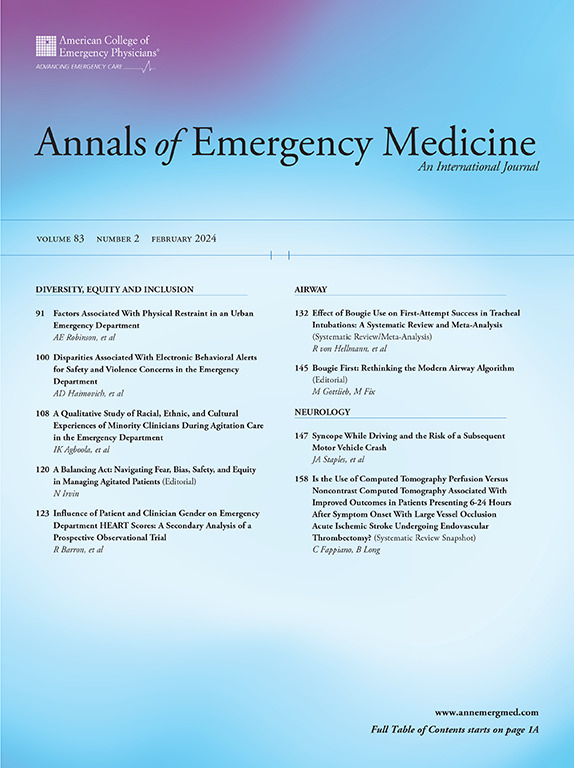Development and Evaluation of a Novel Resuscitation Teamwork Model for Out-of-Hospital Cardiac Arrest in the Emergency Department
IF 5
1区 医学
Q1 EMERGENCY MEDICINE
引用次数: 0
Abstract
Study objective
Cardiopulmonary resuscitation (CPR) is critical for out-of-hospital cardiac arrest patients but is prone to rapid changes and errors. Effective teamwork and leadership are essential for high-quality CPR. We aimed to introduce the Airway-Circulation-Leadership-Support (A-C-L-S) teamwork model in the emergency department (ED) to address these challenges.
Methods
The study comprised 2 phases. The development phase involved reviewing CPR videos, categorizing problems, and formulating strategies using the Systems Engineering Initiative for Patient Safety model. Resuscitation tasks were organized into A-C-L-S domains using hierarchical task analysis. Equipment and environmental deficits were optimized ergonomically with a pit-crew style arrangement. Mnemonics enhanced teamwork and leadership. The evaluation phase assessed postimplementation ED resuscitation team performance, focusing on adherence, timeliness, and quality of A-C-L-S tasks.
Results
The development phase produced a structured teamwork model, assigning tasks, tools, mnemonics, and positions based on A-C-L-S domains. The A-team manages the airway and optimizes end-tidal CO2 levels; the C-team focuses on high-quality chest compressions and defibrillation. Leadership coordinates resuscitation efforts using goal-directed mnemonics (DABCD2E3), whereas the S-team handles medications, timekeeping, and recording. The evaluation phase showed improvements in adherence and timeliness of A-C-L-S tasks, with sustained increases in chest compression fraction before mechanical CPR, from 67.2% preimplementation to 83.0% postimplementation, 89.1% after 1 year, and 86.1% after 2 years. Overall, chest compression fraction also improved from 81.7% to 88.6%, peaking at 92.2% after 1 year and maintaining 90.8% after 2 years.
Conclusion
The A-C-L-S teamwork model is feasible, applicable, and effective. Further research is needed to assess its influence on patient outcomes.
开发和评估针对急诊科院外心脏骤停的新型复苏团队合作模式。
研究目的:心肺复苏术(CPR)对院外心脏骤停患者至关重要,但容易出现快速变化和错误。有效的团队合作和领导力是高质量心肺复苏术的关键。我们旨在将气道-循环-领导-支持(A-C-L-S)团队合作模式引入急诊科(ED),以应对这些挑战:研究分为两个阶段。开发阶段包括回顾心肺复苏视频、对问题进行分类,并使用 "患者安全系统工程倡议 "模型制定策略。使用分层任务分析法将复苏任务划分为 A-C-L-S 领域。设备和环境方面的缺陷通过维修组式的安排进行了人体工程学优化。记忆法增强了团队合作和领导力。评估阶段对实施后急诊室复苏团队的表现进行了评估,重点关注A-C-L-S任务的坚持性、及时性和质量:结果:开发阶段产生了一个结构化团队合作模型,根据 A-C-L-S 领域分配任务、工具、记忆法和职位。A 组负责管理气道并优化潮气末二氧化碳水平;C 组侧重于高质量的胸外按压和除颤。领导层使用目标引导记忆法(DABCD2E3)协调复苏工作,而 S 组则负责药物、计时和记录。评估阶段的结果表明,A-C-L-S 任务的坚持率和及时性都有所提高,机械心肺复苏前的胸外按压率持续上升,从实施前的 67.2% 提高到实施后的 83.0%,1 年后提高到 89.1%,2 年后提高到 86.1%。总体而言,胸外按压率也从 81.7% 提高到 88.6%,1 年后达到 92.2%,2 年后维持在 90.8%:结论:A-C-L-S 团队合作模式是可行、适用和有效的。结论:A-C-L-S 团队合作模式可行、适用且有效,需要进一步研究以评估其对患者预后的影响。
本文章由计算机程序翻译,如有差异,请以英文原文为准。
求助全文
约1分钟内获得全文
求助全文
来源期刊

Annals of emergency medicine
医学-急救医学
CiteScore
8.30
自引率
4.80%
发文量
819
审稿时长
20 days
期刊介绍:
Annals of Emergency Medicine, the official journal of the American College of Emergency Physicians, is an international, peer-reviewed journal dedicated to improving the quality of care by publishing the highest quality science for emergency medicine and related medical specialties. Annals publishes original research, clinical reports, opinion, and educational information related to the practice, teaching, and research of emergency medicine. In addition to general emergency medicine topics, Annals regularly publishes articles on out-of-hospital emergency medical services, pediatric emergency medicine, injury and disease prevention, health policy and ethics, disaster management, toxicology, and related topics.
 求助内容:
求助内容: 应助结果提醒方式:
应助结果提醒方式:


